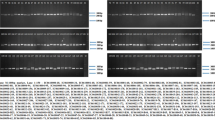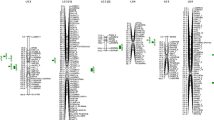Abstract
In Laminaria japonica Aresch breeding practice, two quantitative traits, frond length (FL) and frond width (FW), are the most important phenotypic selection index. In order to increase the breeding efficiency by integrating phenotypic selection and marker-assisted selection, the first set of QTL controlling the two traits were determined in F2 family using amplified fragment length polymorphism (AFLP) and simple sequence repeat (SSR) markers. Two prominent L. japonicas inbred lines, one with “broad and thin blade” characteristics and another with “long and narrow blade” characteristics, were applied in the hybridization to yield the F2 mapping population with 92 individuals. A total of 287 AFLP markers and 11 SSR markers were used to construct a L. japonica genetic map. The yielded map was consisted of 28 linkage groups (LG) named LG1 to LG28, spanning 1,811.1 cM with an average interval of 6.7 cM and covering the 82.8% of the estimated genome 2,186.7 cM. While three genome-wide significant QTL were detected on LG1 (two QTL) and LG4 for “FL,” explaining in total 42.36% of the phenotypic variance, two QTL were identified on LG3 and LG5 for the trait “FW,” accounting for the total of 36.39% of the phenotypic variance. The gene action of these QTL was additive and partially dominant. The yielded linkage map and the detected QTL can provide a tool for further genetic analysis of two traits and be potential for maker-assisted selection in L. japonica breeding.



Similar content being viewed by others
References
Abe J, Tsuda C (1988) Distorted segregation in the backcross progenies between Beta vulgaris L. and B. macrocarpa Guss. Japan J Breed 38:309–318
Abe K (1939) Mitosen in sporangium von Laminaria japonica Aresch. Sci Rep Tohoku Imp Univ 14:327–329
Andersson L, Georges M (2004) Domestic-animal genomics: deciphering the genetics of complex traits. Nat Rev Genet 5:202–212
Bai G, Tefera H, Ayele M, Nguyen HT (1999) A genetic linkage map of tef (Eragrostis tef (Zucc.) Trotter) based on amplified fragment length polymorphism. Theor Appl Genet 99:599–604
Edwards KJ, Barker JH, Daly A, Jones C, Karp A (1996) Microsatellite libraries enriched for several microsatellite sequences in plants. Bio Techniques 20:758–760
Fang TC, Jiang BY, Li JJ (1965) Further studies of the genetics of Laminiaria frond-length. Oceanologia Et Limnologia Sinica 65(1):59–66
Feng L, Tang XX, Zhang Y (2005) The advancement on breeding and seed-rearing technology in kelp. Sci Tech Engng 5(8):491–495 (in Chinese with English abstract)
Gebhardt C, Ritter E, Barone A et al (1991) RFLP maps of potato and their alignment with the homologous tomato genome. Theor Appl Genet 83:49–57
Jung G, Coyne DP, Skroch PW et al (1996) Molecular markers associated with plant architecture and resistance to common blight, web blight, and rust in common beans. J Amer Soc Hort Sci 1996(121):794–803
Kianian SF, Quiros CF (1992) Generation of a Brassica oleracea composite RFLP map: linkage arrangements among various populations and evolutionary implications. Theor Appl Genet 84:544–554
Korol A, Shirak A, Cnaani A, Hallerman EM (2007) Detection and analysis of quantitative trait loci (QTL) for economic traits in aquatic species. In: Liu Z (ed) Aquaculture genome technologies. Blackwell, Oxford, pp 169–197
Kosambi DD (1944) The estimation of map distance from recombination values. Ann Eugen 12:172–175
Lander ES, Green P, Abrahamson J et al (1987) MAPMAKER: an interactive computer package for constructing primary genetic linkage maps of experimental and natural populations. Genomics 1:174–181
Lewis RJ, Jiang BY, Neushul M, Fei XG (1993) Haploid parthenogenetic sporophytes of Laminaria japonica (Phaeophyceae). J Phycol 29:363–369
Li XJ, Cong YZ, Yang GP, Shi YY et al (2007a) Trait evaluation and trial cultivation of Dongfang No. 2, the hybrid of a male gametophyte clone of Laminaria longissima (Laminariales, Phaeophyta) and a female one of L. japonica. J Appl Phycol 19:139–151
Li YH, Yang YX, Liu JD, Wang XL, Gao TX, Duan DL (2007b) Genetic mapping of Laminaria japonica and L. lentissimo using amplified fragment length polymorphism markers in a “two-way pseudo-testcross” strategy. J Integr Plant Biol 49:392–400
Lima M, Souza C, Bento D, Souza A, Carlini-Garcia L (2006) Mapping QTL for grain yielding and plant traits in a tropical maize. Mol Breed 17(3):227–239
Liu FL, Wang XL, Yao JT, Fu WD, Duan DL (2009) Development of expressed sequence tag-derived microsatellite markers for Laminaria Japonica Aresch. J Appl Phycol. doi:10.1007/s10811-009-9426-9
Lu ZX, Sisinski B, Reighard GL, Baird WV, Abbott AG (1998) Construction of a genetic linkage map and identification of AFLP loci linked to root-knot nematodes in peach rootstocks. Genome 41:199–207
Mohan M, Nair S, Bhagwat A et al (1997) Genome mapping, molecular markers and marker-assisted selection in crop plants. Mol Breeding 3:87–103
Murigneux A, Baud S, Beckert M (1993) Molecular and morphological evaluation of doubled-haploid lines in maize. 2. Comparison with single-seed-descent lines. Theor Appl Genet 87:278–287
Postlethwait JH, Johnson SL, Midson CN et al (1994) A genetic linkage map for the zebrafish. Science 264:699–703
Shi YY, Yang GP, Liu YJ (2007) Development of 18 polymorphic microsatellite DNA markers of Laminaria japonica (Phaeophyceae). Mol Ecol Notes 7:620–622
Stuber CW, Edwards MD, Wendel JF (1987) Molecular-markerfacilitated investigations of quantitative trait loci in maize. II. Factors influencing yield and its component traits. Crop Sci 27:639–648
Tseng CK (1983) Common seaweeds of china. Science, Beijng, p 206
Ulloa M, Meredith WR, Shappley ZE et al (2002) RFLP genetic linkage maps from four F (2.3) populations and a joinmap of Gossy pium hirsutun L. Theor Appl Genet 104:200–208
Voorips RE (2002) MapChart: software for the graphical presentation of linkage maps and QTLs. J Hered 93:77–78
Vos P, Hogers R, Bleeker M et al (1995) AFLP: a new technique for DNA fingerprinting. Nucleic Acids Res 23:4407–4414
Wang QY (1984) A study of the heritability and genotypic correlation of some economic characters of L. japonica Aresch. Journal of Shangdong College of Oceanology 14:65–76
Wang SC, Basten CJ, Zeng ZB (2003) Program in statistical genetics. North Carolina State University, Raleigh WinqtlCart Version 2.0
Wang XL, Yang YX, Cong YZ, Duan DL (2004) DNA fingerprinting of selected Laminaria (Phaeophta) gametophytes by RAPD markers. Aquaculture 238:143–153
Wang XL, Liu CL, Li XJ, Cong YZ, Duan DL (2005) Assessment of genetic diversities of selected Laminaria (Laminarales, Phaeophta) gametophytes by inter-simple sequence repeat analysis. J Integr Plant Biol 47:753–758
Wu CY, Lin GH (1987) Progress in the genetics and breeding of economic seaweeds in China. Hydrobiologia 151(152):57–61
Yabu H (1973) Alternation of chromosome in the life history of Laminaria japonica Aresch. Bull Fac Fish Hokkaido Univ 23:171–176
Yabu H, Yasui H (1991) Chromosome number in four species of Laminaria (Phaeophyta). Jap J Phycol 39:185–187
Zemke-White WL, Ohno M (1999) World seaweed utilization: An end-of-century summary. J Appl Phycol 11:369–376
Zeng ZB (1994) Precision mapping of quantitative trait loci. Genetics 136:1457–1468
Zhang QS, Liu SP, Qu SC, Tian ZP et al (2001) Studies on rearing new variety of kelp “901”. Transactions of Oceanology and Limnology 2:46–53
Zhou LR, Dai JX, Shen SD (2004) An improved chromosome preparation from male gametophyte of Laminaria japonica (Heterokontophyta). Hydrobiologia 512:141–144
Acknowledgement
The authors want to thank Donald Sturge for the English revision of the manuscript and also acknowledge the significant contributions of the anonymous reviewers. This research was supported by Key Lab of Marine Bioactive Substances, State Oceanography Administration, and funded by Natural Science Foundation of China No. 30500383 to X. L. Wang, and Knowledge innovation program (KSCXZ-YW-N-47-02) of Chinese Academy of Sciences and Shandong Agricultural Seed Stock Breeding Project granted to D. L. Duan.
Author information
Authors and Affiliations
Corresponding authors
Rights and permissions
About this article
Cite this article
Liu, F., Shao, Z., Zhang, H. et al. QTL Mapping for Frond Length and Width in Laminaria japonica Aresch (Laminarales, Phaeophyta) Using AFLP and SSR Markers. Mar Biotechnol 12, 386–394 (2010). https://doi.org/10.1007/s10126-009-9229-7
Received:
Accepted:
Published:
Issue Date:
DOI: https://doi.org/10.1007/s10126-009-9229-7




